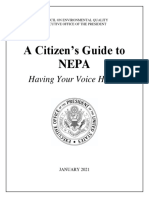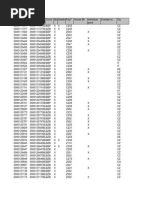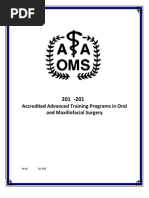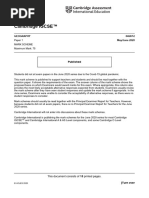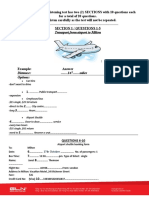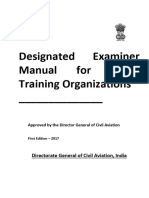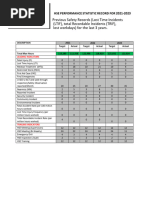Cambridge IGCSE™: Geography 0460/11 October/November 2021
Cambridge IGCSE™: Geography 0460/11 October/November 2021
Uploaded by
Jasmine UhmCopyright:
Available Formats
Cambridge IGCSE™: Geography 0460/11 October/November 2021
Cambridge IGCSE™: Geography 0460/11 October/November 2021
Uploaded by
Jasmine UhmOriginal Title
Copyright
Available Formats
Share this document
Did you find this document useful?
Is this content inappropriate?
Copyright:
Available Formats
Cambridge IGCSE™: Geography 0460/11 October/November 2021
Cambridge IGCSE™: Geography 0460/11 October/November 2021
Uploaded by
Jasmine UhmCopyright:
Available Formats
Cambridge IGCSE™
GEOGRAPHY 0460/11
Paper 1 October/November 2021
MARK SCHEME
Maximum Mark: 75
Published
This mark scheme is published as an aid to teachers and candidates, to indicate the requirements of the
examination. It shows the basis on which Examiners were instructed to award marks. It does not indicate the
details of the discussions that took place at an Examiners’ meeting before marking began, which would have
considered the acceptability of alternative answers.
Mark schemes should be read in conjunction with the question paper and the Principal Examiner Report for
Teachers.
Cambridge International will not enter into discussions about these mark schemes.
Cambridge International is publishing the mark schemes for the October/November 2021 series for most
Cambridge IGCSE™, Cambridge International A and AS Level components and some Cambridge O Level
components.
This document consists of 19 printed pages.
© UCLES 2021 [Turn over
0460/11 Cambridge IGCSE – Mark Scheme October/November
PUBLISHED 2021
Generic Marking Principles
These general marking principles must be applied by all examiners when marking candidate answers.
They should be applied alongside the specific content of the mark scheme or generic level descriptors
for a question. Each question paper and mark scheme will also comply with these marking principles.
GENERIC MARKING PRINCIPLE 1:
Marks must be awarded in line with:
• the specific content of the mark scheme or the generic level descriptors for the question
• the specific skills defined in the mark scheme or in the generic level descriptors for the question
• the standard of response required by a candidate as exemplified by the standardisation scripts.
GENERIC MARKING PRINCIPLE 2:
Marks awarded are always whole marks (not half marks, or other fractions).
GENERIC MARKING PRINCIPLE 3:
Marks must be awarded positively:
• marks are awarded for correct/valid answers, as defined in the mark scheme. However, credit
is given for valid answers which go beyond the scope of the syllabus and mark scheme,
referring to your Team Leader as appropriate
• marks are awarded when candidates clearly demonstrate what they know and can do
• marks are not deducted for errors
• marks are not deducted for omissions
• answers should only be judged on the quality of spelling, punctuation and grammar when these
features are specifically assessed by the question as indicated by the mark scheme. The
meaning, however, should be unambiguous.
GENERIC MARKING PRINCIPLE 4:
Rules must be applied consistently, e.g. in situations where candidates have not followed
instructions or in the application of generic level descriptors.
GENERIC MARKING PRINCIPLE 5:
Marks should be awarded using the full range of marks defined in the mark scheme for the question
(however; the use of the full mark range may be limited according to the quality of the candidate
responses seen).
GENERIC MARKING PRINCIPLE 6:
Marks awarded are based solely on the requirements as defined in the mark scheme. Marks should
not be awarded with grade thresholds or grade descriptors in mind.
© UCLES 2021 Page 2 of 19
0460/11 Cambridge IGCSE – Mark Scheme October/November
PUBLISHED 2021
Question Answer Marks
1(a)(i) When people migrate/move/the movement of people from one place/country 1
to another/live in a new location/move home
1 mark
1(a)(ii) Areas or settlements such as: 2
Agricultural/farming area;
Village;
Hamlet.
2 @ 1 mark
1(a)(iii) Ideas such as: 3
Economic migration/for employment;
To escape persecution/refugees/asylum seekers/war/conflict;
For education;
For better health care;
Lack of food supply;
Lack of water/sanitation;
Natural hazards or examples such as drought;
Etc.
3 @ 1 mark
1(a)(iv) Ideas such as: 4
Some countries are overpopulated/other countries are underpopulated;
Pressure on resources or e.g. such as
housing/food/water/healthcare/education;
Need for some countries to attract people to work/other countries have
enough workers/skilled workers/do low paid/better paid jobs;
Tax income/bigger market;
Countries have different political views/attitudes/worries about crime/to
avoid racial tension;
Some countries belong to political unions which allow free movement of
people;
Some countries encourage migrants to attend educational institutions;
Cultural exchange/dilution;
Ageing population/attract people with families;
Etc.
4 @ 1 mark
1(b)(i) Ideas such as: 3
More men/less women;
Large proportion of economically active/few dependents;
Males mainly aged 20 to 39/30 to 34 years old;
Females mainly aged 15 to 29 years old;
Females younger/males older;
Few/small percentage over 55/60 years/old (dependent);
Few/small percentage of young (dependent)/under 9 etc.
3 @ 1 mark
© UCLES 2021 Page 3 of 19
0460/11 Cambridge IGCSE – Mark Scheme October/November
PUBLISHED 2021
Question Answer Marks
1(b)(ii) Ideas such as: 5
Imbalanced population structure/high dependent population;
Relatively few men remain/population mainly women;
Lower fertility/birth rates;
Reduction in economically active/workforce;
Examples such as loss of farmers/teachers/skilled/educated;
Returning migrants bring back skills;
Jobs become available;
Less money coming into households;
Food production declines/abandoned farms/yields lower;
Loss of social cohesion/families are split/loneliness;
HIV/AIDS;
Remittances/financial boost for families remaining;
Less pressure on health/education services;
Closure of schools/hospitals/businesses/lack of clients/customers;
Less investment by Government;
Etc.
5 @ 1 mark or development
© UCLES 2021 Page 4 of 19
0460/11 Cambridge IGCSE – Mark Scheme October/November
PUBLISHED 2021
Question Answer Marks
1(c) Levels marking 7
Level 1 (1–3 marks)
Statements including limited detail which describe the difficulties faced by
migrants when moving to and/or settling in a new country.
Level 2 (4–6 marks)
Uses named example.
More developed statements which describe the difficulties faced by migrants
when moving to and/or settling in a new country.
(Note: Max 5 if no named or inappropriate example)
Level 3 (7 marks)
Uses named example.
Comprehensive and accurate statements describe the difficulties faced by
migrants when moving to and settling in a new country, including some
place specific reference.
Content Guide:
Answers are likely to refer to:
Moving to:
– Cost of transport
– Distance/difficulty/danger of journey
– Difficulty of obtaining work VISA/Green card etc.
Settling in:
– Difficulty in obtaining job
– Language problems
– Unable to afford housing
– Discrimination etc.
Place specific reference is likely to consist of:
Named parts of the chosen country,
Population data etc.
Note: Credit any scale of international migration.
Question Answer Marks
2(a)(i) Waterland….Alkmaar…..Noordkop 1
Correct order needed
1 mark
2(a)(ii) Closer to Amsterdam = more commuters/further away = less commuters (1 2
mark);
e.g. there are more commuters from Utrecht than Noordkop and Utrecht is
closer to Amsterdam (1 mark);
However there are exceptions;
2 @ 1 mark
© UCLES 2021 Page 5 of 19
0460/11 Cambridge IGCSE – Mark Scheme October/November
PUBLISHED 2021
Question Answer Marks
2(a)(iii) Ideas such as: 3
Many travel by car;
Most commuters are travelling at the same time/workplaces start and finish
at same time;
Many workplaces are concentrated in certain areas of city/e.g.
CBD/industrial areas;
Many use the main roads leading to urban areas/many use the same roads;
Road network is not designed to cope with volume of traffic;
People are reluctant to use/don’t use public transport;
Many areas are poorly served by public transport etc.
3 @ 1 mark
2(a)(iv) Ideas such as traffic congestion: 4
Delays/cause people to be late for work/school/to destination/time wasted;
Results in loss of revenue for businesses/goods delivery delayed;
Cause road rage/frustration/stress;
Uses more fuel;
Increased accidents;
Delays emergency services;
Result in atmospheric pollution/asthma/lung disease;
Increase noise levels;
Result in loss of time/revenue for businesses/goods delivery delayed;
Note: Can be phrased either way e.g. traffic congestion leads to more
accidents or reduction leads to reduced accidents.
4 @ 1 mark
© UCLES 2021 Page 6 of 19
0460/11 Cambridge IGCSE – Mark Scheme October/November
PUBLISHED 2021
Question Answer Marks
2(b)(i) Build Park and Ride facilities: 3
Build car parks on the edge of a city and provided public transport/bus/train
into the centre
Reduce cost of public transport:
Lower amount which needs to be paid to use buses/trains/trams.
Introduce congestion charges at peak times:
Raise costs to motorists which have to be paid when they enter a specific
area (or example) at a busy time/rush hour
Build a metro:
Construct an under/overground rail system/monorail
Car license plate restrictions:
Cars with specific registrations can only enter certain area/use specific
roads on certain days.
Pedestrianization:
Prevent traffic using specific roads/allow only people on foot into certain
areas
Create cycle lanes:
Allow only people riding bicycles to use parts of the road
3 @ 1 mark
2(b)(ii) Answer will depend on strategy selected (no mark for selection). 5
Credit advantages of the strategy
E.g. Build Park and Ride facilities:
Traffic is reduced on main roads within the urban area;
Journey time is quicker;
There is no need to park in the congested central region;
Costs are reduced for commuters;
Access central area;
Air pollution reduced;
Noise pollution reduced;
Less accidents;
Can pedestrianize central areas
5 @ 1 mark or development
© UCLES 2021 Page 7 of 19
0460/11 Cambridge IGCSE – Mark Scheme October/November
PUBLISHED 2021
Question Answer Marks
2(c) Levels marking 7
Level 1 (1–3 marks)
Statements including limited detail which describe the problems caused by
urban sprawl.
Level 2 (4–6 marks)
Uses named example.
More developed statements which describe the problems caused by urban
sprawl.
(Note: Max 5 if no named or inappropriate example)
Level 3 (7 marks)
Uses named example.
Comprehensive and accurate with some place specific reference.
Content Guide:
Loss of rural amenity value
Traffic congestion around edge of urban area
Atmospheric pollution around edge of urban area
Noise
Loss of farmland/reduced food production
Loss of habitat
Threat to species etc.
Question Answer Marks
3(a)(i) D 1
1 mark
3(a)(ii) sun rises in a clear sky 2
cumulus clouds are formed
sky becomes covered by clouds
heavy rain falls
by sunset the sky is clear
Correct order = 2 marks
3 or 4 correctly placed = 1 mark
2 marks
3(a)(iii) Ideas such as: 3
They are close to the Equator/low latitudes;
Sun is (almost) overhead/high angle (90 degrees);
Concentrated rays/direct sunlight/rays concentrated in small area;
High/maximum insolation;
There are no changes during the year in wind direction/angle of sun
3 @ 1 mark
© UCLES 2021 Page 8 of 19
0460/11 Cambridge IGCSE – Mark Scheme October/November
PUBLISHED 2021
Question Answer Marks
3(a)(iv) Processes such as: 4
Heating
Evaporation;
Transpiration;
Air/water vapour rises;
Cooling of air/water vapour (at high levels);
Condensation;
Saturation etc.
Note: Accept names of processes or description.
4 @ 1 mark
3(b)(i) Links such as: 3
Wildlife eats plants or e.g. (caterpillar eats booyong leaves);
Birds/snakes eat small creatures or e.g. (forest owl eats possum);
Nutrients from (dead) animals returned to soil/creatures faeces fertilize the
soil;
Soil enables plants to grow/vegetation uses nutrients;
Population of species kept in check/in balance
Etc.
3 @ 1 mark
3(b)(ii) Ideas such as: 5
Dense vegetation/closely packed
layers;
emergents;
canopy;
Tall/long/straight trees/trunks;
Drip tip/waxy leaves;
Lianas/creepers;
Undergrowth/shrub layer;
Buttress roots;
Shallow roots;
Evergreen/flower all year;
Lots of/brightly coloured/flowers/berries/fruits;
5 @ 1 mark or development
© UCLES 2021 Page 9 of 19
0460/11 Cambridge IGCSE – Mark Scheme October/November
PUBLISHED 2021
Question Answer Marks
3(c) Levels marking 7
Level 1 (1–3 marks)
Statements including limited detail which explain why deforestation of
tropical rainforests is taking place.
Level 2 (4–6 marks)
Uses named example
Developed statements which explain why deforestation of tropical
rainforests is taking place.
(Note: Max 5 if no named or inappropriate example.)
Level 3 (7 marks)
Comprehensive and accurate statements including some place detail.
Content Guide:
Answers are likely to include the following ideas:
Logging/timber;
E.g. such as hardwood/firewood/paper making/furniture/for export/building
materials
Mining
E.g. for oil/iron ore
Road building/railways/transport;
For access to resources/transport of timber/to connect areas of
mining/logging or e.g. Trans-Amazonian Highway;
Settlement/build houses/growth of cities;
Resettlement schemes/increasing population growth;
Industrial development/build factories;
Processing of raw materials/resources or egs;
Dams/reservoirs;
For generation of HEP
Agriculture
For Subsistence/commercial reasons
Little regulation/enforcement of regulations;
Profit is being put before the environment
Place reference is likely to consist of:
Names of places within the rainforest
Specific developments etc.
© UCLES 2021 Page 10 of 19
0460/11 Cambridge IGCSE – Mark Scheme October/November
PUBLISHED 2021
Question Answer Marks
4(a)(i) Large sections/part of the earth`s crust/large slab of solid rock floating on 1
the mantle
1 mark
4(a)(ii) A = Eurasian (Plate) 2
B = Pacific (Plate)
2 @ 1 mark
4(a)(iii) Ideas such as: 3
Uneven/clustered;
Linear/in lines;
Along plate margins/edges/between two plates or example;
Around the Pacific Ocean/Ring of Fire;
South East/Eastern Asia and Western North/South/Central America OR In
the West and East (of the world);
On/near coastlines;
Down the centre of the Atlantic Ocean etc.
3 @ 1 mark
4(a)(iv) Ideas such as: 4
South American and Nazca/plates move towards each other/converge;
Subduction or description;
Destruction of crust/melting of rocks/creation of magma;
Build up of magma/pressure;
Magma escapes/rises (through cracks)
Etc.
4 @ 1 mark
4(b)(i) Problems such as: 3
Falling homes;
Cars/examples of possessions damaged;
Workplaces destroyed;
Hospitals/schools/shops destroyed;
Roads/bridge/motorway damaged;
Port destroyed/closed;
Dam may be destroyed/flooding (from reservoir);
People/farm animals/livestock killed/injured;
Electricity/water/gas supplies/sewage system damaged;
Fires
3 @ 1 mark
© UCLES 2021 Page 11 of 19
0460/11 Cambridge IGCSE – Mark Scheme October/November
PUBLISHED 2021
Question Answer Marks
4(b)(ii) Ideas such as: 5
Pressure on living space;
Cannot afford to move;
Friends/family live there;
They have lived there all their lives/sentimental attraction;
Work is there;
Education is there;
Confidence in precautions;
E.g. construction of earthquake proof buildings/evacuation
plans/drills/emergency service prepared;
Prepared to take risk/don’t happen often etc.
5 @ 1 mark or development
© UCLES 2021 Page 12 of 19
0460/11 Cambridge IGCSE – Mark Scheme October/November
PUBLISHED 2021
Question Answer Marks
4(c) Levels marking 7
Level 1 (1–3 marks)
Statements including limited detail which describe the positive and/or
negative impacts of volcanic activity.
Level 2 (4–6 marks)
Uses named example
Developed statements which describe the positive and/or negative impacts
of volcanic activity.
(Note: Max 5 if no named or inappropriate example.)
Level 3 (7 marks)
Comprehensive and accurate statements which describe the positive and
negative impacts of volcanic activity including some place specific
reference.
Content Guide:
Answers are likely to include the following ideas:
Death/injury
Loss of/damage to property/possessions
Damage to workplaces
Destruction of crops/livestock
Damage to roads
Tourists are attracted
Geothermal power
Soil fertility will be increased in the long term etc.
Developed statements can describe how for example lava impacts people or
can describe in detail the impact.
Place specific reference is likely to consist of:
Locational details
Specific details of eruption/date/time
Details of damage caused/loss of life
Names of plates
Statistical information
Note: Case study must be a named volcano or small place e.g. Montserrat
or La Palma
© UCLES 2021 Page 13 of 19
0460/11 Cambridge IGCSE – Mark Scheme October/November
PUBLISHED 2021
Question Answer Marks
5(a)(i) Nomadic herding 1
1 mark
5(a)(ii) Olives; 2
Fruit;
Sugar beet;
Cereals.
2 @ 1 mark
5(a)(iii) Ideas such as near Latakia; 3
High(er) rainfall;
Fertile soil near Latakia
Irrigation is possible;
Produce can be (more) easily exported/traded;
There is a big(ger) local market;
Great(er) range of crops can be grown;
Nomadic herding is for subsistence/arable is commercial/for profit;
Etc.
Accept references to either Latakia or Tadmur but no double credit.
3 @ 1 mark
5(a)(iv) Ideas such as: 4
Farmers have to fight in army/reduced labour force/farmers
killed/evacuated;
Crops/supplies destroyed/animals killed/farmland damaged;
Unsafe to farm due to bombing/mines/farmers too scared to work in fields;
Government investment in farming reduced due to war effort/spend all the
money on the army/divert food for the army;
Unable to transport food/unable to import food;
Country split so one part may not have agricultural land;
Etc.
4 @ 1 mark
5(b)(i) Ideas such as: 3
Fig. 5.2 is arable/crops but Fig. 5.3 is pastoral/animals;
Fig. 5.2 is producing rice but Fig. 5.3 is producing lamb/wool;
Fig. 5.2 is subsistence/feed themselves but 5.3 is commercial/make a profit;
Fig. 5.2 is flooded/irrigated but 5.3 is not;
Fig. 5.2 is intensive but Fig. 5.3 is extensive;
Fig. 5.2 has smaller fields;
Fig. 5.2 has flatter land;
Fig. 5.2 is using more labour/does more jobs by hand;
Fig. 5.3 has mud bunds around field but Fig. 5.3 has trees/fences;
Etc.
3 @ 1 mark
© UCLES 2021 Page 14 of 19
0460/11 Cambridge IGCSE – Mark Scheme October/November
PUBLISHED 2021
Question Answer Marks
5(b)(ii) Ideas such as: 5
High land may be extremely cold;
Preventing the growth of some crops;
High land has more rainfall;
Flat land/gently sloping land is needed for cultivation/cattle;
Flat land can easily be mechanized;
Flat land has more fertile soils;
Slopes may be well drained/have more run off;
Slopes susceptible to soil erosion;
Steep slopes can be used for grazing animals/sheep/goats;
As they can cope on sloping land;
Flat land is needed for rice cultivation;
So that the fields can be easily flooded when required;
Aspect determines how much sunshine an area has;
South facing slopes are better in northern hemisphere for ripening of e.g.,
vines;
Flat land may be easier to irrigate;
River in valley allows irrigation/floods;
Etc.
Credit named crops/animals as dev.
5 @ 1 mark or development
© UCLES 2021 Page 15 of 19
0460/11 Cambridge IGCSE – Mark Scheme October/November
PUBLISHED 2021
Question Answer Marks
5(c) Levels marking 7
Level 1 (1–3 marks)
Statements including limited detail which describe the effects of food
shortages.
Level 2 (4–6 marks)
More developed statements which describe the effects of food shortages.
Level 3 (7 marks)
Comprehensive and accurate statements which describe the effects of food
shortages including some place reference.
Content Guide:
Answers are likely to refer to:
People cannot feed their families
Price increase
No surplus for sale/export
Starvation
Malnutrition
Overseas food aid
Increased death rates/lower life expectancy
Children cannot concentrate in school
People become unproductive
Overgrazing
Overcultivation
Deforestation
Outward migration
Cause civil war
Etc.
Place specific reference is likely to consist of:
Names of places and schemes within chosen region/country
Specific details/statistics
© UCLES 2021 Page 16 of 19
0460/11 Cambridge IGCSE – Mark Scheme October/November
PUBLISHED 2021
Question Answer Marks
6(a)(i) The steps through/things done/procedures in a factory OR where 1
materials/parts/inputs/raw materials are changed together into a final
product/output/occur in a factory
1 mark
6(a)(ii) Ideas such as: 2
Highly mechanised/automated/uses machines/advanced
technology/computers;
Capital intensive;
Few employees;
Each employee is doing a different job;
Modern/up to date
Etc.
2 @ 1 mark
6(a)(iii) Ideas such as: 3
Fuels are not burnt/required/fuels only used to power the machines;
Water not needed;
There would be few/no waste products;
Atmosphere will not be polluted/less emissions/no smoke/no greenhouse
gases created;
Rivers/oceans/water will not be polluted/no liquid waste to dispose of etc
3 @ 1 mark
6(b)(i) Ideas such as: 3
Fig. 6.2 is older;
Fig. 6.2 is larger;
Fig. 6.2 has more storeys;
Fig. 6.2 is brick built but Fig. 6.3 is built with prefabricated sheets;
Fig. 6.2 has more windows.
3 @ 1 marks
6(b)(ii) Ideas such as: 4
If manufacturing industries are located close to raw materials/market
transport costs will be reduced;
If raw materials are bulky industries need to be close to them/near the port;
If raw materials are perishable the industry needs to be close to them;
If finished products are bulky industries need to be close to the
market/cities;
If finished products are perishable the industry needs to be close to the
market/cities;
4 @ 1 mark
© UCLES 2021 Page 17 of 19
0460/11 Cambridge IGCSE – Mark Scheme October/November
PUBLISHED 2021
Question Answer Marks
6(b)(iii) Reasons could include reference to: 5
Move to a more modern building;
More environmentally friendly/more efficient in terms of layout (dev)
Canal/water transport no longer;
Goods now moved by road/too slow to transport by water (dev)
Lack of space/need to expand;
Too many other industries taking up the nearby space (dev)
The areas roads may be congested/narrow;
And much time will be wasted in traffic (dev)
Excessive cost of land;
Cheaper land may be available on edge of city (dev)
Government incentives/disincentives or examples;
E.g. tax concessions, subsidies for locating in enterprise zones (dev)
Consideration of areas where labour is cheaper/more available;
E.g. in LEDCs where wages are low, areas of high unemployment (dev)
Growth of new markets/closer to bigger market
In areas where population is growing rapidly (dev)
Move away from competitors;
So that they can sell items without competition (dev)
Move to be close to suppliers/natural resources/other branches of company/
initial supplies of raw materials used up;
To reduce transport costs (dev);
Near to an airport;
For access to international markets (dev)
Authorities taking action about/complaints from residents about noise/air
pollution etc.;
Which would prevent them from producing at full capacity (dev)
5 @ 1 mark or development
Note:.
1 Points can be credited for development or stand-alone ideas.
2 Development ideas are just examples and are not exhaustive
3 Only allow 1 × dev mark for each idea
© UCLES 2021 Page 18 of 19
0460/11 Cambridge IGCSE – Mark Scheme October/November
PUBLISHED 2021
Question Answer Marks
6(b)(c) Levels marking 7
Level 1 (1–3 marks)
Statements including limited detail which explain how the environmental
risks are being managed.
Level 2 (4–6 marks)
Uses named example.
More developed statements which explain how the environmental risks are
being managed.
(Note: Max 5 if no named or inappropriate example)
Level 3 (7 marks)
Uses named example.
Comprehensive and accurate statements including some place specific
reference.
Content Guide:
Answers can refer to any economic activity at any scale:
E.g. logging
Agriculture
Manufacturing
Mining/quarrying
Tourism etc.
Management will depend on economic activity chosen.
E.g. tourism
Restrict numbers of tourists
Ecotourism
Creation of National Parks
Banning of vehicles close to attractions
Use of guides
Education about impacts of tourism on environment
Litter bins
Restrict access to sensitive areas etc.
Culture conflict etc.
Place specific reference is likely to consist of:
Locational details;
Names of places within chosen area
Specific details/statistics
Note: Named location must be smaller than a country and a named activity
© UCLES 2021 Page 19 of 19
You might also like
- SHARP - SPLIT TYPE - AIR - CONDITION - Ah-Ay-Au-Ae-X075e-X095e - SM - GB PDFDocument65 pagesSHARP - SPLIT TYPE - AIR - CONDITION - Ah-Ay-Au-Ae-X075e-X095e - SM - GB PDFnkor6574No ratings yet
- En650 DJF (Vulcan S 2018-20) PDFDocument108 pagesEn650 DJF (Vulcan S 2018-20) PDFAlbert DepanoNo ratings yet
- Information Management ScopeDocument16 pagesInformation Management ScopeJm seNo ratings yet
- SCFS23 Day 1 - Full Day SlidesDocument39 pagesSCFS23 Day 1 - Full Day SlidesJoaquin DuranyNo ratings yet
- 2019 ACE 2u Adv Prelim - ExamDocument19 pages2019 ACE 2u Adv Prelim - ExamYon Seo YooNo ratings yet
- Crispr PosterDocument1 pageCrispr Posterapi-638550362No ratings yet
- Stanislawski - Origin and Spread of Grid-Pattern TownDocument17 pagesStanislawski - Origin and Spread of Grid-Pattern TownGemmy100% (1)
- Data Sheet: SAW DuplexerDocument24 pagesData Sheet: SAW DuplexerHongdang DinhNo ratings yet
- Accounting Policies of ZomatoDocument8 pagesAccounting Policies of Zomatopius pintoNo ratings yet
- TFL Bus Spider Map For Ealing CommonDocument1 pageTFL Bus Spider Map For Ealing Commonhrpwmv830% (1)
- A Proposed Deped Administration Biulding Extension: Spe Statement of The ProblemDocument3 pagesA Proposed Deped Administration Biulding Extension: Spe Statement of The ProblemAr-ar RealuyoNo ratings yet
- Data Warehouse Schemas For Decision SupportDocument13 pagesData Warehouse Schemas For Decision SupportJeevanantham GovindarajNo ratings yet
- Broadcom 9400 Tri-Mode Controller TK WebinarDocument28 pagesBroadcom 9400 Tri-Mode Controller TK WebinarLaszlo KrenczNo ratings yet
- NO PLNT Tag No Material Description MRP Remark Rop Max Material Code QTY Install Spare Parts ClassDocument2 pagesNO PLNT Tag No Material Description MRP Remark Rop Max Material Code QTY Install Spare Parts ClassAri Wibowo100% (1)
- Polycab HT XLPE Cable CatlougeDocument36 pagesPolycab HT XLPE Cable CatlougeManoj Kumar PanigrahiNo ratings yet
- Gzikp Gqht?Apb NKC FJT (WB WZRFBZR O (Bi 2013 D/ O (Bi 4 (1) NB ( Ko TH Nrb/Oh Ekotkjh Ehsh Ikt/, I' J/M NB ( Ko J?LDocument8 pagesGzikp Gqht?Apb NKC FJT (WB WZRFBZR O (Bi 2013 D/ O (Bi 4 (1) NB ( Ko TH Nrb/Oh Ekotkjh Ehsh Ikt/, I' J/M NB ( Ko J?LFUTURE STATIONNo ratings yet
- 2jiajiri Scholarship Application Form: FoundationDocument3 pages2jiajiri Scholarship Application Form: Foundationalinory KWENANo ratings yet
- Challan AxisDocument3 pagesChallan AxisSumit Darak50% (2)
- Year 6 - Unit 1 - WWA - 22 - 23Document5 pagesYear 6 - Unit 1 - WWA - 22 - 23Amit SrivastavaNo ratings yet
- International Brazilian Jiu-Jitsu Federation: Renew Membership IdDocument1 pageInternational Brazilian Jiu-Jitsu Federation: Renew Membership Idadrian chavezNo ratings yet
- GBG Idscan Ieos Web API v4Document16 pagesGBG Idscan Ieos Web API v4Laberto KelenNo ratings yet
- Wendra Deka Saputra: P R O F Il EDocument1 pageWendra Deka Saputra: P R O F Il EvheNo ratings yet
- Prospect & Problems in Tourism Sector in Hakaluki Haor, MoulovibazarDocument27 pagesProspect & Problems in Tourism Sector in Hakaluki Haor, Moulovibazarfariha.swarna09No ratings yet
- Synthesis of Some New Pyridazine Derivatives For ADocument15 pagesSynthesis of Some New Pyridazine Derivatives For ADrHamdy KhameesNo ratings yet
- Food Recognition and Calorie Measurement UsingDocument7 pagesFood Recognition and Calorie Measurement UsingBelther LeccaNo ratings yet
- WiFi RS232 Adapter Quick Reference WA232EDocument7 pagesWiFi RS232 Adapter Quick Reference WA232EAnonymous rrD8UKYNXNo ratings yet
- Digitalization of Securities MarketDocument8 pagesDigitalization of Securities Marketmrinal kumarNo ratings yet
- 64 - HT Jan 2018Document16 pages64 - HT Jan 2018Aakash MinochaNo ratings yet
- List of Micro Presentation Topics 2021 - AdmissionsDocument11 pagesList of Micro Presentation Topics 2021 - AdmissionsFyi death is meNo ratings yet
- Chapter2 MAS202Document43 pagesChapter2 MAS202Quỳnh VânNo ratings yet
- Account of Shambuji Maharaj in London GazetteDocument2 pagesAccount of Shambuji Maharaj in London GazetteStukalofthNo ratings yet
- POL111Document237 pagesPOL111Hope MathewNo ratings yet
- Federal Public Service Commission: Important Notice (Must Read Carefully To Ensure Compliance)Document2 pagesFederal Public Service Commission: Important Notice (Must Read Carefully To Ensure Compliance)Afaq Khan100% (1)
- Shiva ChauhanDocument2 pagesShiva Chauhanshiva chauhanNo ratings yet
- LDR Format Description v2Document38 pagesLDR Format Description v2test100% (1)
- RFP Document For AEDocument262 pagesRFP Document For AEDattaNo ratings yet
- Talk Tech: 1,000 Point ClubDocument12 pagesTalk Tech: 1,000 Point ClubPhillipMichaelLeblancNo ratings yet
- Ricoh Aficio MP7000 Trouble Error CodesDocument35 pagesRicoh Aficio MP7000 Trouble Error CodesnafeesNo ratings yet
- Billet PDF V2Document2 pagesBillet PDF V2Md ShahedNo ratings yet
- The Molecular Mechanism of Acetaminophen Toxicity in Dogs & Cats - ACVIM 2008 - VINDocument10 pagesThe Molecular Mechanism of Acetaminophen Toxicity in Dogs & Cats - ACVIM 2008 - VINKakiNo ratings yet
- A Case Solution of DarazDocument22 pagesA Case Solution of DarazMd AbdullahNo ratings yet
- Citizens Guide To Nepa 2021Document37 pagesCitizens Guide To Nepa 2021Bryan TuckerNo ratings yet
- CV Sebastien Froelich 2021Document28 pagesCV Sebastien Froelich 2021Marcelo DàvilaNo ratings yet
- III Eee II Sem Ic Lab Manual (Ee 383)Document66 pagesIII Eee II Sem Ic Lab Manual (Ee 383)NaveenNo ratings yet
- Bank Account Analysis BBP - BZBDocument102 pagesBank Account Analysis BBP - BZBMonique HostynNo ratings yet
- Nguyen T T M 2007 Textbook Evaluation THDocument73 pagesNguyen T T M 2007 Textbook Evaluation THTran Thi Tieu ThuNo ratings yet
- Seminar Report 2021-22 Deep WebDocument19 pagesSeminar Report 2021-22 Deep WebClassic PrintersNo ratings yet
- Westermo MG 6101-3201 WeosDocument1,215 pagesWestermo MG 6101-3201 WeosserkalemtayeNo ratings yet
- Saer ElettropompeDocument37 pagesSaer ElettropompeCarlos Samper BaidezNo ratings yet
- 英文说明书 (1) (ECP COMFORT GP-2000)Document28 pages英文说明书 (1) (ECP COMFORT GP-2000)BryanJermyHendrikNo ratings yet
- Adhaar FormDocument1 pageAdhaar FormKrishan Kumar100% (1)
- Transparency and Algorithmic Governance PDFDocument57 pagesTransparency and Algorithmic Governance PDFannas fahlevieNo ratings yet
- Img 20220701 0001Document1 pageImg 20220701 0001syaukani saputraNo ratings yet
- Oopr212 Midterms ReviewerDocument10 pagesOopr212 Midterms Reviewershawn mallariNo ratings yet
- Manual4 PDFDocument428 pagesManual4 PDFtalk2hemi2598No ratings yet
- Brain Fog in Menopause A Health Care Professional S Guide For Decision Making and Counseling On CognitionDocument10 pagesBrain Fog in Menopause A Health Care Professional S Guide For Decision Making and Counseling On CognitionMarcia GouveiaNo ratings yet
- How To Crip Walk - 5 Steps (With Pictures) - WikihowDocument1 pageHow To Crip Walk - 5 Steps (With Pictures) - WikihowNouka VENo ratings yet
- CAPR 21 0567finalDocument15 pagesCAPR 21 0567finalabdulrazaqNo ratings yet
- Entrepreneur: Nagavara Ramarao Narayana MurthyDocument3 pagesEntrepreneur: Nagavara Ramarao Narayana MurthyJANHAVI DIXITNo ratings yet
- AAOMS Residency Program ListDocument12 pagesAAOMS Residency Program Listlippincott2011No ratings yet
- Central Vietnam Tour PackageDocument14 pagesCentral Vietnam Tour PackageRaks veerNo ratings yet
- Cambridge IGCSE™: Geography 0460/12 February/March 2022Document16 pagesCambridge IGCSE™: Geography 0460/12 February/March 2022Mimi XoaNo ratings yet
- 0460_s20_ms_12Document15 pages0460_s20_ms_12Hannah CervantesNo ratings yet
- New To Range nk2 2023 - enDocument140 pagesNew To Range nk2 2023 - enpapirelliNo ratings yet
- Passion Pro 100 TR 2014Document94 pagesPassion Pro 100 TR 2014Faker FockerNo ratings yet
- 9 - Stefan Becker - Mattia Corti - First RNP AR H Procedures and Drone OperationsDocument22 pages9 - Stefan Becker - Mattia Corti - First RNP AR H Procedures and Drone Operationsw8c6sdw9b2No ratings yet
- Transport From Airport To Milton: 17th OctoberDocument3 pagesTransport From Airport To Milton: 17th OctoberHoàng Thảo VânNo ratings yet
- Way Leave Policy LetterDocument10 pagesWay Leave Policy LetterPunitSinghNo ratings yet
- PV776 21012011Document100 pagesPV776 21012011programacion1No ratings yet
- Unit 5 NotesDocument85 pagesUnit 5 NotesCHINMAY SUNIL PHUTAKNo ratings yet
- Blue Minimalist Business Pitch Deck PresentationDocument19 pagesBlue Minimalist Business Pitch Deck PresentationsparkgroupnpNo ratings yet
- S770 Hyd SJC V-1605Document2 pagesS770 Hyd SJC V-1605Teknik MakinaNo ratings yet
- Kavach installation in one day flow chartDocument1 pageKavach installation in one day flow chartudaygupta678No ratings yet
- Transportation Law DigestsDocument14 pagesTransportation Law DigestsNehemiah MontecilloNo ratings yet
- DFT - DE ManualDocument39 pagesDFT - DE ManualatploxfNo ratings yet
- Al FarisDocument1 pageAl FarisctrlaltdestroyNo ratings yet
- Fitment Guide 2020Document82 pagesFitment Guide 2020Rob100% (1)
- Model FA (Vacuum Servo)Document54 pagesModel FA (Vacuum Servo)Komatsu Perkins Hitachi100% (1)
- JCB Generators: More Power To YouDocument8 pagesJCB Generators: More Power To YoualiasgarNo ratings yet
- Lion Air ETicket (ASEMCJ) - TampomuriDocument4 pagesLion Air ETicket (ASEMCJ) - TampomuriEmilly MGM TravelindoNo ratings yet
- Task Card A2 Bolkow - Engine InstallationDocument12 pagesTask Card A2 Bolkow - Engine InstallationHighboisNo ratings yet
- 5.2.SAFETY, HEALTH & ENVIRONMENT-HSE Performance Statistics-Previous Safety Records (Lost Time Incidents (LTIF)Document1 page5.2.SAFETY, HEALTH & ENVIRONMENT-HSE Performance Statistics-Previous Safety Records (Lost Time Incidents (LTIF)LLOYD LloydNo ratings yet
- Executive Summary Pkg-03Document20 pagesExecutive Summary Pkg-03ashish kUmarNo ratings yet
- Unit 42 - Highway Engineering Assignment 1 (Set C)Document9 pagesUnit 42 - Highway Engineering Assignment 1 (Set C)shoon laeNo ratings yet
- KLAXEDDM PDF 12dec22Document16 pagesKLAXEDDM PDF 12dec22Benoit VoisinNo ratings yet
- TPFEPL Company BrochureDocument18 pagesTPFEPL Company BrochurepadeepNo ratings yet
- Sea Ports of CHINADocument4 pagesSea Ports of CHINASantanu KonarNo ratings yet
- The Oblong Box: Edgar Allan PoeDocument9 pagesThe Oblong Box: Edgar Allan PoeJose P MedinaNo ratings yet
- Cat-Pag 5Document2 pagesCat-Pag 5Walter FormigoniNo ratings yet
- Your Electronic Ticket Receipt-23Document2 pagesYour Electronic Ticket Receipt-23bryanNo ratings yet









































